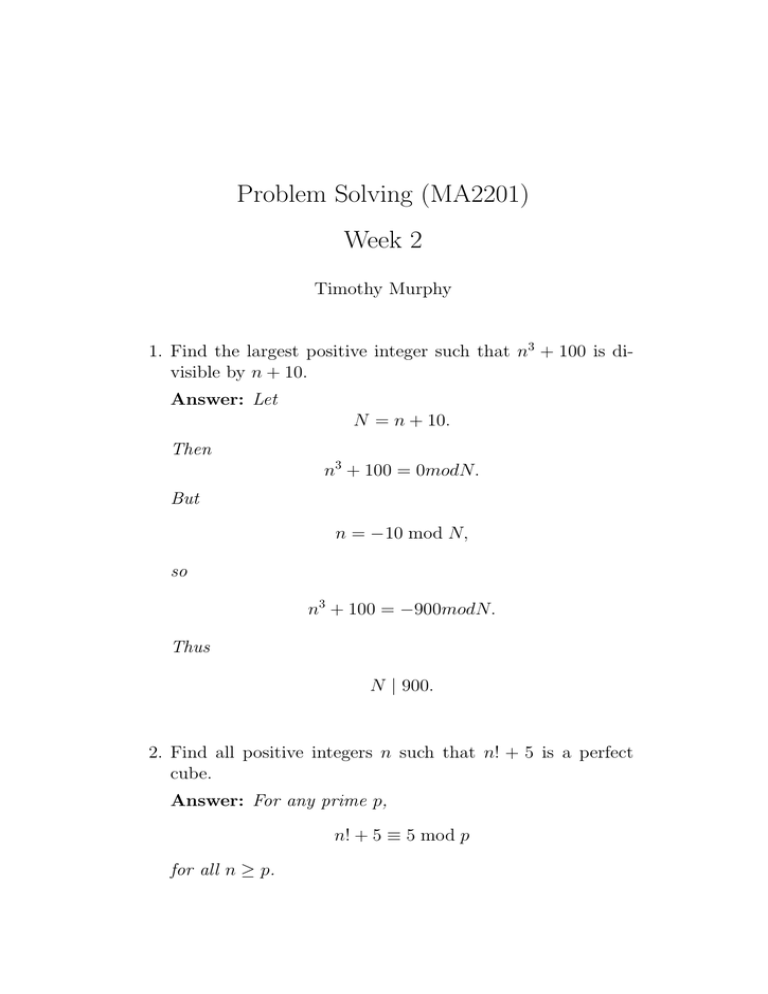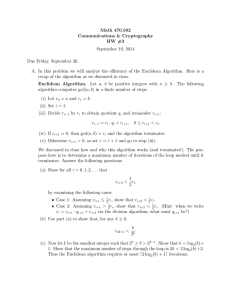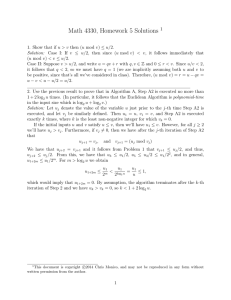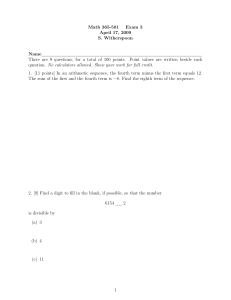Problem Solving (MA2201) Week 2
advertisement

Problem Solving (MA2201)
Week 2
Timothy Murphy
1. Find the largest positive integer such that n3 + 100 is divisible by n + 10.
Answer: Let
N = n + 10.
Then
n3 + 100 = 0modN.
But
n = −10 mod N,
so
n3 + 100 = −900modN.
Thus
N | 900.
2. Find all positive integers n such that n! + 5 is a perfect
cube.
Answer: For any prime p,
n! + 5 ≡ 5 mod p
for all n ≥ p.
So if n! + 5 is a perfect cube, then 5 is a cubic residue
modp
Recall that (Z/p)× is a cyclic group of order p − 1.
If 3 - p − 1 then the homomorphism
x 7→ x3 : (Z/p)× → (Z/p)×
has trivial kernel, and so is surjective, ie every element is
a cubic residue.
But if 3 | p − 1 then the kernel contains just 3 elements (the
elements of order 3), and so (p − 1)/3 elements are cubic
residues, so there is a reasonable chance the 5 will not be.
Take p = 7. There are 6/3 = 2 cubic residues, namely
±1 mod p. So 5 is not a cubic residue mod 7, and it follows
that n! + 5 cannot be a cube if n ≥ 7.
Checking n! + 5 for n < 7 we see that the only cube occurs
when n = 5.
3. Show that the product of 4 successive integers cannot be a
perfect square.
Answer:
Method 1 Let the successive integers be n, n + 1, n + 2, n +
3.
We have
n(n + 3) = n2 + 3n, (n + 1)(n + 2) = n2 + 3n + 2.
Thus
n(n + 3) < (n + 1)(n + 2),
and so
[n(n + 3)]2 < n(n + 1)(n + 2)(n + 3) < [(n + 1)(n2 )]2 .
Also
(n + 1)(n + 2) = n(n + 3) + 2.
Thus if n(n + 1)(n + 2)(n + 3) is a perfect square, we
must have
n(n + 1)(n + 2)(n + 3) = [n(n + 3) + 1]2 /
But that is impossible, since the left-hand side is even
while the right-hand side is odd, since one of n, n + 3
is even.
Method 2 Suppose n(n + 1)(n + 2)(n + 3) is a perfect
square.
Suppose first that 3 - n.
Two of the numbers are even, and two are odd. Suppose
n, n + 2 are even. Then
gcd(n, n + 1) = 1, gcd(n, n + 2) = 2, gcd(n, n + 3) = 1, gcd(n + 1, n + 2)
It follows that
n = 2a2 , n + 1 = b2 , n + 2 = 2c2 , n + 3 = d2 .
But then
b2 < n + 3 < (b + 1)2 = n + 2 + 2b.
So n + 2 cannot be a square (unless b = 0).
In the same way, if n + 1, n + 3 are even then
n = a2 , n + 1 = 2b2 , n + 2 = c2 , n + 3 = 2d2 .
Again,
a2 < n + 2 < (a + 1)2 .
Now suppose 3 | n. Then 3 | n, n + 3.
Suppose n, n + 2 are even. Then
gcd(n, n + 1) = 1, gcd(n, n + 2) = 2, gcd(n, n + 3) = 3, gcd(n + 1, n + 2)
It follows that
n = 6a2 , n + 1 = b2 , n + 2 = 2c2 , n + 3 = 3d2 .
Can we go on from here?
4. Find the positive integer n for which
[log2 1] + [log2 2] + [log2 3] + · · · + [log2 n] = 2010,
where [x] denotes the greatest integer ≤ x.
Answer: Let
N (n) = [log2 1] + [log2 2] + [log2 3] + · · · + [log2 n].
We have
[log r] = 0 if r = 1
[log r] = 1 if r = 2, 3
[log r] = 2 if 4 ≤ r < 8
...
[log r] = e − 1 if 2e−1 ≤ r < 2e .
Hence
N (2e − 1) =
e
2X
−1
[log r]
1
= 0 · 1 + 1 · 2 + 2 · 22 + ... + (e − 1)2e−1 .
Let
f (x) = 1 + x + x2 + ... + xe−1
xe − 1
=
x−1
Then
f 0 (x) = 1 + 2x + ... + (e − 1)xe−2
exe−1
xe − 1
=
−
x − 1 (x − 1)2
Hence
N (2e − 1) = 2f 0 (2)
= 2e2e−1 − 2(2e − 1)
= (e − 2)2e + 2.
In particular
N (29 − 1) = 7 · 28 + 2
ie
N (511) = 1538
After this we are adding 8 for each number. Since
1538 = 2 mod 8,
we get numbers = 2 mod 8, such as 2010.
5. If the number n is chosen at random, what is the probability
that 2n ends in 2?
6. If the number n is chosen at random, what is the probability
that 2n starts with 1?
7. Let us say that a number is almost-prime if it is not divisible
by 2,3,5 or 7. How many almost-prime numbers are there
less than 1,000?
Answer: Let S(r) be the natural numbers ≤ 1000 that are
divisible by r:
S(r) = {1 ≤ n ≤ 1000 : r | n}.
Then
#S(r) = [1000/r].
We have to determine the number of elements in
X = [1, 1000] \ (S(2) ∪ S(3) ∪ S(5) ∪ S(7)).
By the Principle of Inclusion-Exclusion,
#(S(2) ∪ S(3) ∪ S(5) ∪ S(7)) =#S(2) + #S(3) + #S(5) + #S(7)
− #(S(2) ∩ S(3)) − #(S(2) ∩ S(5)) − #(S(
+ #(S(3) ∩ S(5)) + #(S(3) ∩ S(7)) + #(S(
− #(S(2) ∩ S(3) ∩ S(5)) + #(S(2) ∩ S(5) ∩
− #(S(2) ∩ S(3) ∩ S(7)) − #(S(3) ∩ S(5) ∩
+ #(S(2) ∩ S(3) ∩ S(5) ∩ S(7)
8. 8 people are sitting round a circular table. In how many
ways can they change places so that each person has a different neighbour to the right?
Answer: Let us solve the problem with a set X of n people
around the table. Let the number of solutions be f (n).
For simplicity let us number the people 0, 1, . . . , n−1 mod n.
Consider a permutation π of the set X. Suppose in fact just
r people still have the same person on their right, Then we
can define a permutation σ of the n − r remaining people
X \ S by identifying i with i + 1 if
π(i + 1) ≡ π(i) + 1.
Thus suppose the interval [j, k] ⊂ X, ie
π(i + 1) ≡ π(i) + 1.
for i = j, j + 1, . . . , j + k, but
π(j − 1) 6≡ π(j) − 1, π(k + 1) 6≡ π(k) + 1;
and suppose
π(`) = j.
Then we set
σ(`) = k.
9. If a set of circles is placed in the plane so that no circle in
the set lies inside another one, does it follow that the set is
enumerable?
Answer:
10. Can you find 3integers x, y, z, not all zero, such that
x3 + 2y 3 + 4z 3 = 0?
Answer:
11. What point P in a triangle ABC minimises
AP 2 + BP 2 + CP 2 ?
Answer:
12. Show that in a group of 6 people there are either 3 people
who know each other (“mututal acquaintances”) or 3 people
who don’t know each other (“Mutual strangers”)
Answer:
13. Show that the complex numbers x, y, z form an equilateral
triangle if and only if
x2 + y 2 + z 2 = xy + yz + zx.
Answer:
14. Show that in any graph with at least 2 vertices there must
be 2 vertices with the same degree. (The degree of a vertex
is the number of edges with an end-point at that vertex.)
Answer:
15. Show that for any k > 2 one can find k integers 0 < a1 <
a2 < · · · < ak such that
1
1
1
+
+ ···
= 1.
a1 a2
ak
Answer: We have
1 1 1
+ + = 1.
2 3 6
Suppose
1
1
1
+
+ ···
= 1.
a1 a2
ak
Then
1
1
=
k
ak
1 1 1
+ +
2 3 6
=
1
1
1
+=
+=
,
2ak
3ak
6ak
giving a sum of the same kind with 2 additional terms.
The sum
1 1
+ =1
2 2
gives successive sums with 4, 6, 8, . . . terms, while
1 1 1
+ + = 1.
2 3 6
gives successive sums with 5, 7, 9, . . . terms.
Thus we have solutions for all k ≥ 3.
Challenge Problem
Do there exist primes p, q such that
p | q(q − 1) + 1 and q | p(p − 1) + 1?
Answer:








